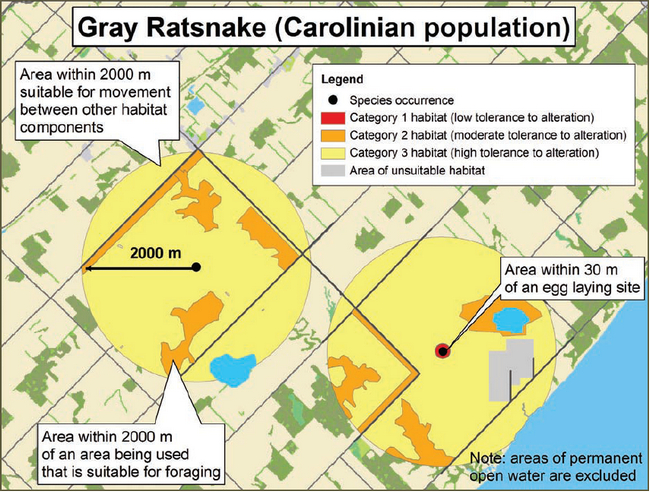Gray Ratsnake (Carolinian Population) Habitat Protection Summary
This document provides a brief description of the area that is protected as habitat for the Gray Ratsnake (Carolinian population) through a habitat regulation under the Endangered Species Act.
The Gray Ratsnake is Ontario’s largest snake reaching lengths of up to 1.85 metres. In southwestern Ontario, it can be found in a wide variety of natural and cultural habitats, although it has a preference for forests, savannah and forest edges. The Carolinian population was assessed by the Committee on the Status of Species at Risk in Ontario (COSSARO) and listed as endangered on September 10, 2009. More information about this species' status can be found at: Gray Ratsnake webpage.
Brief description of the habitat regulation
The habitat regulation for Gray Ratsnake (Carolinian population) protects sites used for nesting, hibernation, and communal shedding and basking, as well as areas within 2000 metres of a Gray Ratsnake (Carolinian population) that are suitable for it to carry out its life processes (e.g. foraging and thermoregulation).
The regulation applies where the snake occurs in the following areas: the counties of Brant, Elgin, Haldimand and Norfolk; the Regional Municipality of Niagara; and the Municipality of Southwest Middlesex and the Village of Newbury within the County of Middlesex.
Additional details about this habitat regulation can be found in the following paragraph.
Additional details of the habitat regulation:
The habitat regulation protects important habitat features including hibernacula and 150 metres around hibernacula, as well as natural or non-natural egg laying sites, communal shedding sites and communal basking sites and 30 metres around those sites.
Hibernacula are protected indefinitely as long as the area remains in a suitable condition. Natural egg laying sites, communal shedding sites and communal basking sites are protected until three consecutive years of documented non-use by a Gray Ratsnake (Carolinian population) and during the current season of use until November 30th for non-natural sites.
Areas suitable for foraging, thermoregulation, hibernation and movement within 2000 metres of any area that is used by a Gray Ratsnake (Carolinian population) are also protected. Areas used for thermoregulation, foraging and hibernation include meadow, forest, hedgerow, wetland, shoreline, old field and other similar areas. Other areas, such as active agricultural fields and some urban areas are used primarily for movement and are also included as regulated habitat. Lakes and rivers, below the historic low water mark, are excluded.
Supporting rationale
- An area of 150 metres around a hibernaculum and a distance of 30 metres around an egg laying or communal shedding or basking site is intended to protect the feature itself and the terrestrial area required to maintain the suitability of the site.
- Egg laying sites, communal shedding sites and communal basking sites are used repeatedly over the lifespan of an individual. Naturally occurring sites are protected for three years from last documented use because these features may only be used every two or three years.
- Radio-tracked Gray Ratsnakes (Carolinian population) move an average of 2000 metres from their hibernacula. An area of 2000 metres is meant to protect an individual’s home range, and to provide for all of the habitat components necessary for the species to survive.
Activities in Gray Ratsnake (Carolinian population) habitat
Activities in regulated habitat can continue as long as the function of these areas for the species is maintained and individuals of the species are not killed, harmed, or harassed. For example, agricultural areas are used primarily for movement and are relatively tolerant to alteration; most activities can continue in agricultural areas as long as they do not create a permanent barrier to the movement of snakes through these areas.
Generally compatible:
- Yard work such as lawn care and gardening.
- Continuation of existing agricultural practices such as annual harvest.
- Renovations or the building of small structures such as a shed or a deck.
Generally not compatible*:
- Significant reduction or clearing of natural and semi-natural features, such as forests, woodlands, wetlands, shorelines, rock outcrops, hedgerows, and meadows.
- Large-scale construction, such as a housing development or roads.
- Removal or alteration of documented nesting sites that may be found in rotting logs or compost piles. If these features are man-made (other than hibernacula), they are protected during the season that they are being used by the snake.
*If you are considering an activity that may not be compatible with regulated habitat, please contact your local MNR office for more information.
Key terms
- Communal shedding site: Sites that are used by two or more snakes when moulting their outer layer of skin.
- Hibernacula: Underground features, natural or man-made, extending below the frost line where snakes hibernate to avoid extreme cold temperatures during the winter. Some examples are bedrock crevices, small mammal burrows and building foundations. In the regulation, the hibernaculum includes terrestrial habitat necessary for the site to function as a staging area in the spring and fall.
- Thermoregulation: Some animals, such as snakes, use thermoregulation to alter their internal body temperature through behavioural patterns, such as basking in the sun to increase body temperature or seeking out cool areas to lower body temperature.
Below you will find an example diagram of how this regulation would be applied to protect habitat for this species. It indicates how the protected habitat has been categorized, based on how the species uses the habitat and how much activity or change can occur within the habitat, as per the policy "Categorizing and Protecting Habitat Under the Endangered Species Act". This policy can be found at: Categorizing and Protecting Habitat Under the Endangered Species Act webpage.
Sample application of the Habitat Regulation:

Enlarge Sample application of the Habitat Regulation
The content of this summary is provided for convenience only. For accurate reference and the most recent version of the regulation, please view Ontario Regulation 832/21 on e-Laws